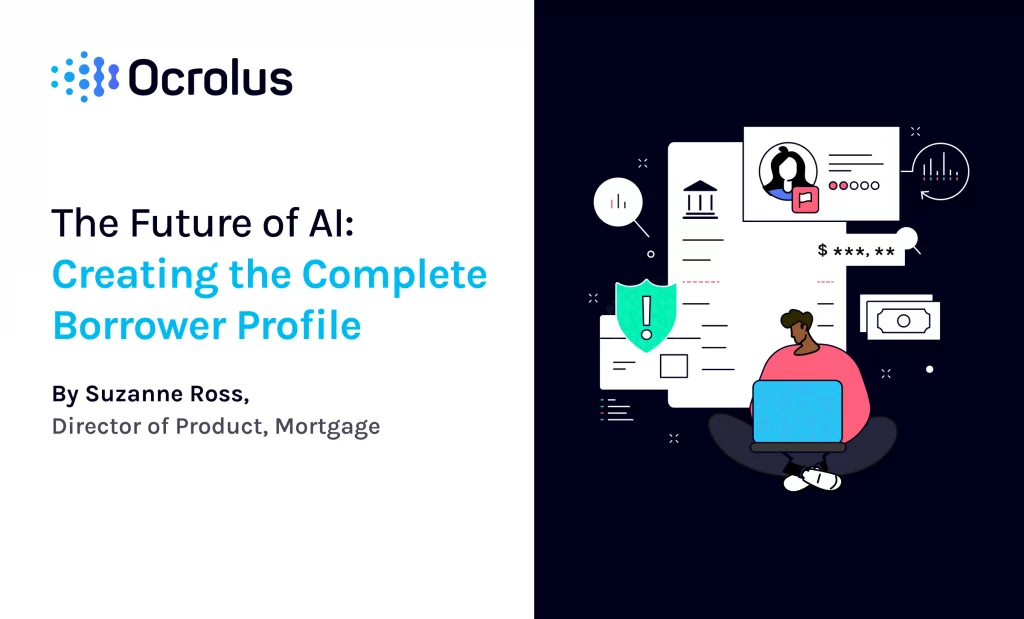This website uses cookies so that we can provide you with the best user experience possible. Cookie information is stored in your browser and performs functions such as recognising you when you return to our website and helping our team to understand which sections of the website you find most interesting and useful.
The Future of AI in Lending: Creating the Complete Borrower Profile

The future of artificial intelligence (AI) in lending might well be captured with one bold mantra: Bigger and better.
AI and machine learning (ML) technologies are already lapping at the edges of what’s possible in the industry. Expect a steep adoption curve in the near future as more robust data can help deliver bigger and better models that financial institutions can deploy in various ways and provide a complete financial picture of applicants.
AI in Lending Today
Lending institutions are already leaning on automation. Robotic process automation (RPA) helps crunch through the mountains of complex paperwork through programmed scripts. A popular use case for ai in lending is when RPA helps reduce manual errors while filling out necessary forms by automatically populating the blank fields with the right information.
Artificial intelligence and machine learning are taking that basic automation a step further. AI algorithms can sift through documents and, equally important, place the digitized information in context, to make credit decisions faster and more reliable. As a result, professionals can leave the mind-numbing tasks to AI and work on areas where human decision-making is more impactful.
In many cases, AI only makes recommendations; the final decision is still human-powered. By augmenting human skills, the AI-human-in-the-loop combination ends up being more productive, with each component playing to its unique skills.
AI’s Future in Lending
The future of AI in the lending industry might not look dramatically different in its applications from what we see today. But AI is expected to deliver new efficiencies even as the profiles and needs of borrowers change.
First, some context. Lending institutions have traditionally adopted conservative approaches to loan applications, combing through pay stubs and W-2s along with credit scores to gauge risk and approve applicants. However, models of employment are changing. More than a third of the U.S. workforce in 2020 was comprised of freelancers, according to Finances Online. So the loan-granting process has to adjust and move toward new ways of ensuring creditworthiness. AI is one of the technologies expected to help the industry solve these challenges – at scale.
Here are five ways we can expect to see in the near to long-term concerning how lending institutions will build and use AI and ML models:
1. Move Toward Eliminating Bias in Lending Models
Expect the industry to tackle the elephant in the room: biased data and underwriting models. Financial institutions’ use of AI has led to criticism of the datasets used in the models as reinforcing existing societal biases. But companies are being more intentional about scrubbing the algorithms free of bias, or at least understanding the basis for AI-aided recommendations before making a final decision. Studies have shown that automation minimizes bias in lending, which is a positive development. Expect to see financial institutions invest more effort in course-correcting AI models to weed out biases and make the data gathering process more transparent.
2. Expanded Pool of Data Points
To accommodate the growing volume of non-traditional loan applicants and gain a more granular picture of their financial backgrounds, expect AI models to look outside the W-2 and pay stub box. AI will analyze novel pools of data outside of the typical loan application process, including cash flows from multiple non-traditional sources. This might be a modern approach that isn’t widely adopted initially as a means to compiling a complete financial picture of the applicant, but helps greatly in obtaining contributing factors for creditworthiness.
For example, job history, education, and GPA might deliver a picture for younger loan applicants with less traditional credit histories. Natural language processing (NLP) will be used for these applications and increasingly pressed into service to parse through volumes of information from which relevant data points can be extracted.
3. More Penetration of the Non-QM market
Applicants who might not check all the boxes for a qualified mortgage (non-QM) are not necessarily high-risk for default. Self-employed borrowers or those who present other ways of qualifying for credit are forming an increasing part of the lending segment and leading to institutions finding other ways of vetting applicants.
This is where AI comes in for lenders. A clearer picture of loan applicants through unconventional methods will also decrease the chances of loan default and help financial institutions better manage risk. In the future, improvements in AI-based credit risk analysis will greatly reduce default rates, and subprime borrowers previously, excluded under less precise rubrics, will have a chance at financing.

4. Customer/Applicant Personalization
Given that banks will be working with more accurate pictures of loan applicants, AI will also help place data in context for personalized guidance and service through the loan process – and beyond.
Once applicants become bank customers, the customer profile can be built out with more data points, including certain milestones throughout the customer’s life. This enables banks to offer timely product and service recommendations based on a borrower’s profile. Since such personalized services are already a part of retail, consumers have become accustomed to this tailored approach. However, it has been underused in the banking and lending sector. In the very near future, AI will be put to its most optimal use by delivering customized and efficient services in lending as well..
5. Faster Processing of Loan Applications
Advances in AI and machine learning in lending will push approval times for most loans to near zero. Bigger loans that once involved long and intensive reviews that lasted weeks, if not months, such as in mortgage lending, will process over many hours. AI models can crunch through volumes of documents and other data points and save not just a borrower’s time, but hours of tedium for the lender.
The future of lending is bright and more equitable, thanks to AI. As the profile of a borrower moves away from the traditional, expect AI to shift accordingly and factor in new ways of granting loans while minimizing risk, and saving time for lenders.
Ocrolus is continually innovating as an AI and automation solution for lending and other complex tasks financial institutions execute. With its AI-driven engine and emphasis on human-in-the-loop decision-making, automation from Ocrolus is the future of the industry.






